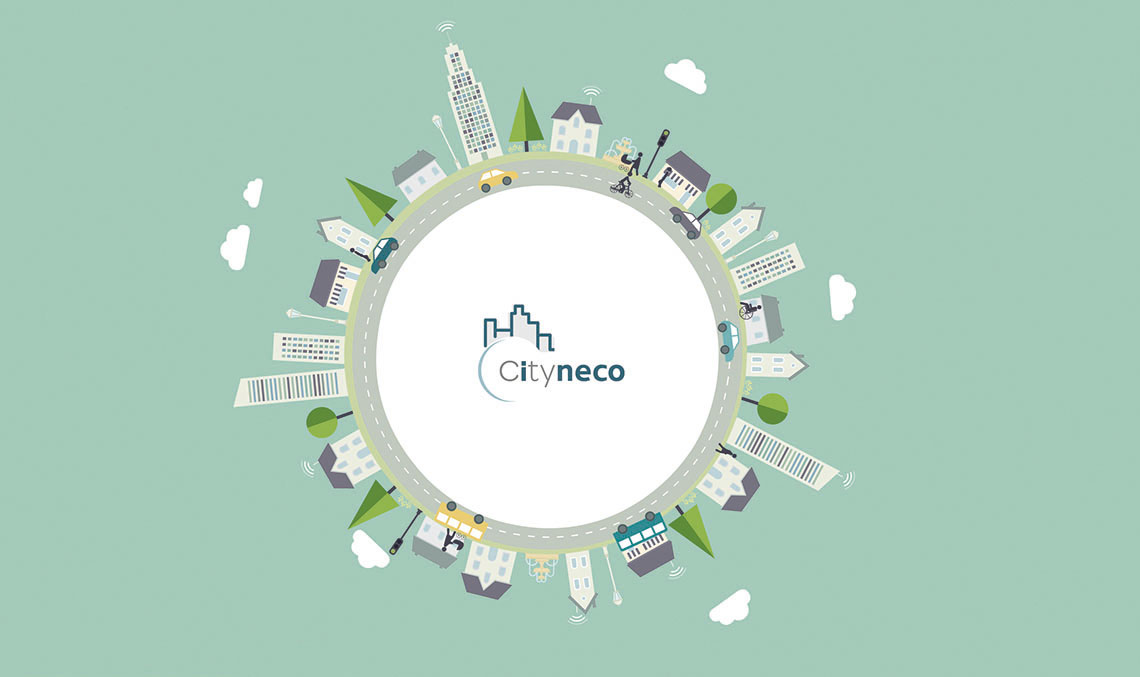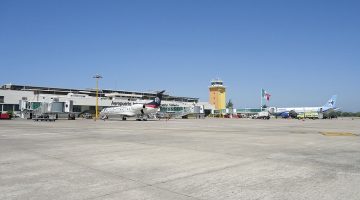While there are still shortcomings in the communication and dissemination of all the initiatives that have been implemented thus far and all the work that has been done to promote the application of new technologies in the improvement of the efficiency of services, and ultimately, the quality of life of citizens, we are beginning to feel the transformation of our cities. Spain is a pioneer and an international point of reference in the development of smart cities thanks to its National Smart Cities Plan. This plan is based on three fundamental pillars: standardization, governance and industry.
The standardization process is centred on the development of the industrial fabric, thanks to the concepts of reuse and interoperability of technological solutions. There are currently 20 UNE standards published within the sphere of Smart Cities, four of them recognised by the ITU as recommendations (Interoperability – ITU-T Y.SSCP, Open data – Y.ODI, Tourist Destinations – Y.STD and Development of Rural Environments – Y.SRC), and more than 20 new standards in progress. Regulatory development concerning smart cities is carried out by the Spanish Association of Standardization (UNE), specifically the Technical Committee for Spanish Standardization on Smart Cities CTN178, of which Ineco is a member. As a result, Spain has developed an important international presence thanks to the strong policy development in this area.
In regard to governance, Spain represents a unique model in the world thanks to the fact that all the agents involved have been part of the development of smart cities. From an institutional point of view, there is coordination of the five ministries with competencies associated with smart cities: Ministry of Finance and Civil Service (MINHAFP), Ministry of Public Works (MFOM), Ministry of Energy, Tourism and the Digital Agenda (MINETAD), Ministry of Agriculture and Fisheries, Food and Environment (MAPAMA) and Ministry of Economy, Industry and Competitiveness (MINECO). To represent the cities, the Spanish Network of Smart Cities (RECI), is formed of 82 cities that account for 40% of the total Spanish population. Representing the industry point of view are the AMETIC (Association of Electronics, Information and Communications Technologies, Telecommunications and Digital Content Companies), CONETIC (Spanish Confederation of Information Technology, Communications and Electronics Companies), GICI (Smart Cities Interplatform Working Group) as well as the sector representatives.
Spain is a pioneer and an international point of reference in the development of smart cities thanks to its National Smart Cities’ Plan
Finally, as far as industry is concerned, both consolidated and emerging industries are available. Additionally, in order to speed up adoption on the part of industry, subsidies for smart city initiatives were announced in 2014 (15 million Euros), 2015 (63 million Euros) and for smart islands in 2015 (30 million Euros). Thanks to our National Smart Cities Plan, innovation and development of the industrial fabric have been made possible, providing realistic technological solutions for cities.
In this area, Ineco works with the Secretary of State for the Information Society and Digital Agenda (SESIAD) at the heart of the National Smart Cities’ Plan through the coordination of public and private initiatives of smart cities and their modelling and dissemination at national and international levels, contributing its extensive experience in the field of smart cities through an expert team of consultants in information technologies and ‘smart products’. In recent years, technological solutions have been implemented for different verticals, especially for the internal management systems of town halls, which often work behind the scenes without citizens being aware them. A vertical could be described as a technological solution aimed at a specific service in a city, such as the management of lighting. These solutions have traditionally been responsible for the control and monitoring of the associated devices.
Other more modern examples include smart car park solutions or traffic optimization solutions, such as the ones developed by Ineco for the mobility vertical in the Cityneco ecosystem, energy efficiency systems, smart irrigation, or measurements of pollutant emissions in the environment vertical, management indicator dashboards, citizen portals and mobile applications for interaction with citizens in the vertical of smart government, and a large variety of products deployed in our cities.
Local intelligence serving global mobility
Our cities are beginning to develop true intelligence. Cities such as Santander, Málaga, Madrid, Valencia, Barcelona and Valladolid have made very significant progress, but it is time to make the leap to the next level and this progress will require two concepts: the vision of the city as interconnected objects and interoperability of the city’s different platforms.
Up to this point, cities have been viewed from the perspective of the services that city councils provided to the citizens. For this reason, the solutions that have been developed have focused on improving the efficiency of these services. But as the development of smart cities has evolved, it has been noted that urban environments have a number of elements that have their own entity, with their own characteristics and needs, and which, though they are not services that constitute a management vertical, do need to be integrated into the brain of the city that is the city platform.
Some examples are the stations, airports, ports and the smart buildings themselves. These elements have a high level of automation and are becoming increasingly intelligent thanks to the intensive use of ICT, but it is necessary to avoid their isolation within the city.
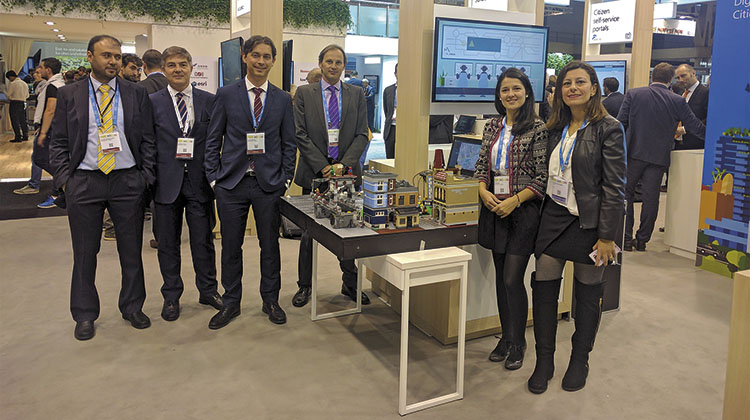
INECO AT THE SMART CITY EXPO WORLD CONGRESS. Ineco’s IT team at the Smart City Expo World Congress/16 in Barcelona. From left to right: Francisco Javier Carvajal, Eloy Cámara, Ignacio Martínez, deputy director of IT, and Jesús Vázquez, alongside them, Ana Olmeda and Natalia Díaz, Knowledge Management manager.
Smart Buildings
Buildings are the main elements of the city and as such, they represent one of the greatest assets of smart cities. In addition to the increasing automation of the internal operation of buildings, work is also being done with the aim of turning them into some of the most important sensors in the city. Buildings have a lot of valuable information that can contribute to both the city and other buildings in terms of energy consumption, as well as alarms in the field of security, environment or sustainability.
Spain is committed to this comprehensive vision and already has a UNE standard for smart buildings. Also, work is being carried out with the industry to define a device to allow all the relevant information to be collected and transmitted to the city in a comprehensive manner.
Smart stations and airports
Analysing smart stations in a similar manner to buildings, we find that they must manage their facilities properly in regard to maintenance and security, as well as in regard to their commercial aspects, exploiting the characteristics of digital marketing and providing travellers with a user experience that makes them feel unique. But communication between the station and the city is essential in order to exchange the information that they both need.
Stations, like ports and airports, constitute a point of entry and, in that sense, are the traveller’s first point of contact with the city. For this reason, they must provide relevant information about the city, so that it can optimize its resources and services in different areas: public transport, mobility, security or tourism.
Cityneco predicts future traffic conditions facilitating optimization of mobility parameters virtually in real time
The use of information by the city, which is aggregated in order to avoid privacy issues, such as the number of travellers expected within a certain time range, can be made available to private agents through a city’s Open Data portals, allowing the development of new business models that improve the range services offered to users, for example, in the tourism sector.
Smart ports
In the case of the analysis of the ports, and to provide a more comprehensive view, we will focus our comments on the area of freight transport. In addition to being the point of arrival of travellers, ports constitute a point of entry of goods to the city. The predicted information regarding the arrival of these goods, as well as their characteristics, is of great value, allowing the city to adapt, taking into account logistical and security aspects based on the volume and types of goods.
The importance of interoperability
All the objectives discussed so far for the elements of cities would be impossible without city platforms. It is in these platforms where the magic of transforming information into knowledge takes place. They allow information to be exchanged between the different services of a city and this combination generates significant added value.
We understand interoperability in different ways. First, cities must be able to evolve and change their platforms over time, if they want to, without affecting the other elements involved. Furthermore, this change may be a comprehensive change of the entire platform or may affect only one part of it.
The second concept of interoperability is centred on the fact that different platforms must be able to communicate with each other; station and airport platforms will need to talk to the city, and the platforms in different cities will in turn also need to talk to each other to exchange information.
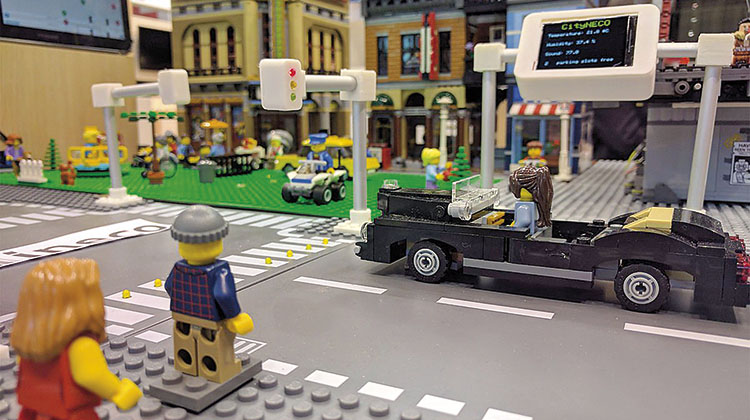
A Lego representation of a smart city, which manages information through the intensive use of ICTs. / PHOTO_ELVIRA VILA
The third concept of interoperability focuses on the business models that will be built on the city’s platforms. Private agents are developing new business models, such as smart parking applications or tourist destinations, and there must be some assurance that the investment made to develop a product for a city will be recovered, with the possibility of implementing the same product in other cities.
To demonstrate the high degree of interoperability of Spanish platforms, SESIAD and Ineco are working on the implementation of virtual laboratories that allow the functional validation of the different solutions developed for smart cities. These laboratories, in turn, make it possible to verify the portability of solutions between different platforms. Smart city platforms have currently been implemented in cities such as Málaga, Valencia or Barcelona, but they are not the only ones that have already taken the step.
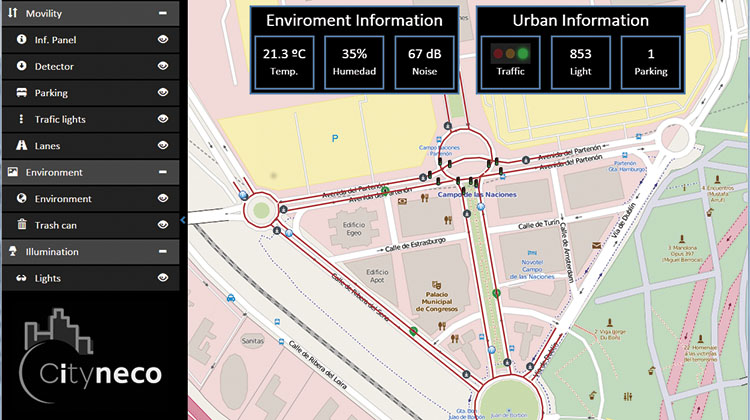
A NEW PLATFORM. In addition to the information from the sensors, the Cityneco platform analyses information from mobile data, GPS and even social networks, which enriches the information on the mobility status in the city.
For these reasons, Spain is a pioneer in the interoperability of smart city platforms. There is a UNE interoperability standard (UNE 178104) that has been proposed as an international standard through the ITU (International Telecommunication Union). Ineco has collaborated since the early stages as a member of the subcommittee that developed the standard, through to its international deployment, providing technical support to SESIAD. Cityneco complies with this standard, so it is completely interoperable.
Regarding all of the above, we can say that the interoperability of these platforms is vital to the development of both Spanish cities and Spanish industry. It is important to remember that our platforms can be exported to other countries.
The National Platform
One thing to keep in mind is that the development of smart cities can lead to increased inequalities among cities, and one of the fundamental factors arising from this is the attraction and capturing of talent. The cities that are undergoing the greatest development in the field of smart cities are generating a pull effect on this talent, which in turn is driving innovation and development of the city itself.
The development of a national platform would allow municipalities with more limited economic capacity to enjoy the benefits of smart cities
Also, cities with more limited resources have less investment capacity and that means that they cannot access solutions that like the city platform that represent the cornerstone of innovation.
In these cases, it may make sense to develop a national platform that allows municipalities with more limited economic capacity to enjoy the benefits of smart city solutions without having to make an investment that, in most cases, is beyond their reach. This national platform would serve these municipalities, allowing savings in acquisition and maintenance costs to each municipality, allowing them to focus their investment on specific vertical solutions to improve the services they provide to their citizens.
Cityneco, a smart platform

Ineco has signed a collaboration agreement with the city of Granada to implement the Cityneco platform. / PHOTO_BÁRBARA JIMÉNEZ-ALFARO
Cityneco is the smart platform developed by Ineco to integrate the different verticals in cities.
The platform makes it possible to connect the city’s different sensors thanks to its IoT (Internet of Things) module, and in turn it can also integrate and process multiple sources of information, from social networks to video images.
- The platform is fully scalable and interoperable thanks to its layered structure, fully compliant with the standardization proposal in the standard. There is also a version that is offered in the form of Software as a Service (SaaS) that allows the development of medium-sized cities, making use of the platform without requiring the city to have its own infrastructure.
- With respect to the use of information, the platform can display dashboards based on real-time information as well as management indicators.
- Within the mobility vertical, Ineco’s solution presents highly innovative features that set it apart from the other solutions available on the market. The platform monitors traffic thanks to the information that it receives from the non-conventional traffic detectors and sensors. The platform then processes the information, taking advantage of the integration with the simulation models, as well as the use of machine learning techniques (artificial intelligence). This makes it possible to predict future traffic conditions, facilitating optimization of mobility parameters virtually in real time. On the other hand, together with the information from the sensors, the platform’s features allow information from mobile data, GPS and even social networks to be analysed, enriching the information on the status of mobility in the city.
- Ineco has signed a collaboration agreement with the city of Granada and is in the process of implementing the Cityneco platform, in order to allow the city to test the capabilities of the Ineco smart platform as well as the mobility vertical.


